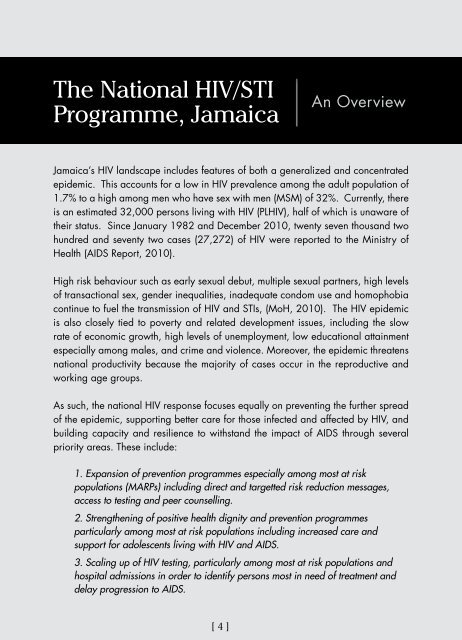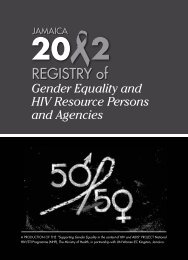Gender Equality and HIV Resource Persons and Agencies
Gender Equality and HIV Resource Persons and Agencies
Gender Equality and HIV Resource Persons and Agencies
Create successful ePaper yourself
Turn your PDF publications into a flip-book with our unique Google optimized e-Paper software.
The National <strong>HIV</strong>/STI<br />
Programme, Jamaica<br />
Jamaica’s <strong>HIV</strong> l<strong>and</strong>scape includes features of both a generalized <strong>and</strong> concentrated<br />
epidemic. This accounts for a low in <strong>HIV</strong> prevalence among the adult population of<br />
1.7% to a high among men who have sex with men (MSM) of 32%. Currently, there<br />
is an estimated 32,000 persons living with <strong>HIV</strong> (PL<strong>HIV</strong>), half of which is unaware of<br />
their status. Since January 1982 <strong>and</strong> December 2010, twenty seven thous<strong>and</strong> two<br />
hundred <strong>and</strong> seventy two cases (27,272) of <strong>HIV</strong> were reported to the Ministry of<br />
Health (AIDS Report, 2010).<br />
High risk behaviour such as early sexual debut, multiple sexual partners, high levels<br />
of transactional sex, gender inequalities, inadequate condom use <strong>and</strong> homophobia<br />
continue to fuel the transmission of <strong>HIV</strong> <strong>and</strong> STIs, (MoH, 2010). The <strong>HIV</strong> epidemic<br />
is also closely tied to poverty <strong>and</strong> related development issues, including the slow<br />
rate of economic growth, high levels of unemployment, low educational attainment<br />
especially among males, <strong>and</strong> crime <strong>and</strong> violence. Moreover, the epidemic threatens<br />
national productivity because the majority of cases occur in the reproductive <strong>and</strong><br />
working age groups.<br />
As such, the national <strong>HIV</strong> response focuses equally on preventing the further spread<br />
of the epidemic, supporting better care for those infected <strong>and</strong> affected by <strong>HIV</strong>, <strong>and</strong><br />
building capacity <strong>and</strong> resilience to withst<strong>and</strong> the impact of AIDS through several<br />
priority areas. These include:<br />
1. Expansion of prevention programmes especially among most at risk<br />
populations (MARPs) including direct <strong>and</strong> targetted risk reduction messages,<br />
access to testing <strong>and</strong> peer counselling.<br />
2. Strengthening of positive health dignity <strong>and</strong> prevention programmes<br />
particularly among most at risk populations including increased care <strong>and</strong><br />
support for adolescents living with <strong>HIV</strong> <strong>and</strong> AIDS.<br />
3. Scaling up of <strong>HIV</strong> testing, particularly among most at risk populations <strong>and</strong><br />
hospital admissions in order to identify persons most in need of treatment <strong>and</strong><br />
delay progression to AIDS.<br />
[ 4 ]<br />
An Overview



